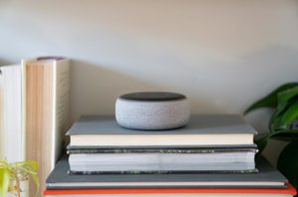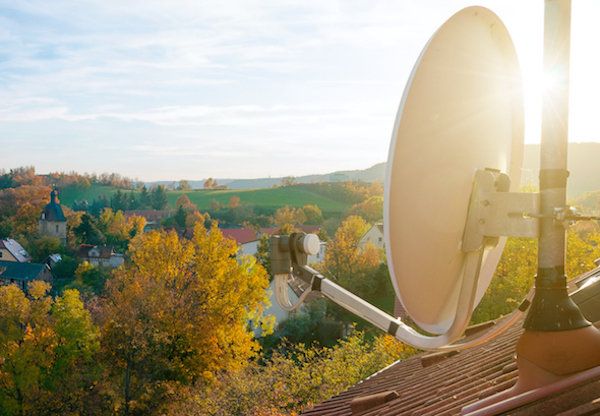Simple steps to turn your house into a smart home without breaking the bank
Smart Home Guide for Budgeters
Smart home technology has gone from being a far fetched dream (remember The Jetsons?) to being concrete reality. You can order a package with voice command, manage the climate of your home when you’re at work, and see who’s at your front door without getting out of bed.
But outfitting your home with smart devices is expensive, right? Actually, not really. You can set up the building blocks of a smart home for just a couple hundred bucks (or less, in some cases).
This guide will walk you through the steps to build a smart home on a shoestring budget. Let’s start with the basics.

Getting started with the essentials
When it comes to cool gadgets, we’re all like little kids on Christmas morning. But, before we jump into the fun stuff, like surround sound audio systems and bluetooth shower heads, let’s go over a few basics.
Make sure your internet is up to the task
We want to help you save money as you set up your smart home, but you shouldn’t cut corners on this one. It’s essential to have fast and reliable internet if you want to have a seamlessly interconnected home.
While each household will be different, we recommend at least 100–200 Mbps for most connected households and up to 1 GB internet speeds for big houses with lots of devices. If you’re not sure how fast your existing internet is, you can test it out using our speed test.
While some smart home devices can use bluetooth, smart hubs, or even wired connections, your Wi-Fi network will be the main way that most of your devices communicate with each other, your personal apps, and the wider world. This means it is also essential to have a powerful modem and router.
We’ve all had the eerie feeling that our smartphones are spying on us (and they kind of are). So it makes sense to be concerned about bringing more smart devices into your home, especially cameras and voice-activated technology. There are some basic steps you can take to secure your smart home and ensure greater privacy, like encrypting your Wi-Fi and getting high-quality devices from reputable brands.
Choose a smart home ecosystem
Smart home devices are kind of like Hogwarts (yep, the wizard school in Harry Potter). You have to figure which house you're in before you can actually start. Rather than Gryffindor and Hufflepuff, you’ve got Amazon Echo, Google Nest, and Apple HomeKit.
If you have a device or several devices from one brand already (if you already have an Amazon Echo speaker or an iPad, for instance) then it might make sense to just stick with that ecosystem. But you might want to start from scratch.
Amazon Echo’s ecosystem is probably the best for budgeters because it offers the most flexibility and, therefore, options of affordable devices. But there are pros and cons for each ecosystem. Here’s a quick breakdown of all three.
Amazon Echo smart home ecosystem
Most people are familiar with Amazon’s Alexa personal assistant at this point. Alexa has been around since 2014, when Amazon introduced its first Echo speaker. Since then, the company has hugely expanded its smart home lineup.
Tons of devices have Alexa built in and even more are compatible with the system, meaning they can be controlled by giving a voice command to your speaker. Adding new devices to your ecosystem is made easy with the Alexa app.
Of all the smart home systems, Amazon Alexa may be the “smartest”. It can answer nearly any question you ask it and can learn different “skills,” which are essentially third-party games, quizzes, news roundups, and other useful voice-driven activities.
Google Nest smart home ecosystem
Google got into the smart home game a little bit later, but the Google Nest ecosystem is quickly catching up to Amazon. Google uses an intelligent voice-command system called Assistant that’s very similar to Alexa.
One advantage to Google Assistant is that it’s already built-in to many Android phones as the default assistant. That means many people may already be using it as they go about their day-to-day activities.
Google’s ecosystem is not as big as Amazon’s, but it does include a bunch of devices. The core device for most people will be a Google Nest speaker (or the older Google Home devices), but there are tons of products from other companies that have Google Assistant built-in or are compatible with it.
Another benefit to using Google’s Assistant is, well, Google. There’s no other digital voice assistant that can answer questions as accurately and helpfully as Google.
Apple HomeKit smart home ecosystem
If you’ve ever had an iPhone, you’re probably familiar with Siri. Apple has expanded its virtual assistant to work with a whole range of smart home devices.
You can use an iPad, Apple computer, or several other devices to operate your Siri-powered smart home, but for the best experience we recommend using a HomePod device. It’s Apple equivalent to Google Nest or Amazon Echo.
While we appreciate the design (of course) and overall functionality of Apple’s HomeKit, there are fewer devices that have the system built-in than for the other two ecosystems. That said, the list of compatible devices is growing, and those who are already embedded in the Apple universe should find plenty to love with HomeKit.
Get a hub (or don’t)
Hubs are devices that help you connect and control all of the devices in your home. A hub can be an important part of a smart home, but it may not be totally necessary for those who want to keep their costs down.
Smart hubs can get really fancy. Some of the best smart hubs can help you connect devices that are on different ecosystems, even if they aren’t technically able to “pair” with each other directly. Hubs can make it easier to connect devices that are in different parts of your home, even those that are far away from each other.
In a way, Amazon Echo, Google Nest, and Apple HomePod are all mini smart hubs because they allow you to communicate with other devices via voice command. For many people, this will be enough, especially if your devices are all in the same ecosystem.
You may have heard or read the letters IFTTT, which stands for If This Then That (it’s a mouthful, we know). IFTTT is a system that allows you to automate certain functions of your smart devices. For example, you can set it up to automatically send screenshots from your Ring doorbell to your iPhone throughout the day.
Devices to consider
The list of smart devices is nearly endless. You can get a refrigerator that talks to you, a toaster that connects to the internet, a mop that kind of looks like miniature R2-D2, and a bunch of other things that most of us probably don’t need, per se.
Here we’re just going to cover some of the more essential and popular smart home devices that you’ll want to invest in, even if you’re trying to be budget conscious. Let’s start with the most basic: smart plugs.
Smart Plugs
Before you invest a bunch of cold hard cash into smart devices, try this smart home hack. Smart plugs can turn many everyday devices and appliances into smart (or at least clever) objects. Have an old lamp? Connect it to a smart plug and you can turn it on and off with your phone! Same goes for air purifiers, air conditioning units, sound systems, and dozens of other items.
Spend less than $100 to throw some high-quality smart plugs in each room of your house and you're basically halfway to having a smart home.
Speakers
We’ve already talked a bit about smart speakers that can operate as mini hubs, like the Amazon Echo. But that’s just the tip of the iceberg. Higher end smart speakers can provide high-quality, far-reaching audio for your phone, computer, TV, and other devices.
If you really want to invest in good sound, check out wireless surround sound systems from companies like Bose, Yamaha, Sonos, and VIZIO. These systems can essentially make your whole home a voice-activated, entertainment center.
Thermostats
What if your house knew exactly when you were going to get back from work and it adjusted the climate accordingly, taking into account the outside temperature, humidity, and weather? Smart thermostats can do that and a lot more.
The best thermostats out there (like the Ecobee SmartThermostat) can control your heating, cooling, air filtration, and hot water systems, among others. You can install occupancy sensors, so the system knows when you’re home and which rooms you’re using, and adjust the climate to suit your needs.
While these systems can cost a few hundred bucks, you will probably notice a lower energy bill in the coming months, so it kind of pays for itself.
Lighting
Photographers and filmmakers can tell you: lighting is everything. It can turn a drab living room into a gorgeous relaxing paradise or a simple dinner table look like a five-star restaurant. So it makes sense to invest in a few smart light bulbs.
You can get smart lights that do all sorts of things, from the basics—remote control and fading—to complex tasks—like changing color and pulsing to the music that’s coming from your smart speaker. You probably don’t need a smart light in every room, but the bigger spaces where you spend a lot of time and entertain are essential.
Home Security
“Smart” technology has probably changed the home security industry more than any other. You can protect and monitor your house from basically anywhere now, using a series of incredible tools.
Top tier home security systems will come with smart cameras, professional monitoring, window sensors, and other features that make it easy to feel safe at home (and away). There are a range of options out there, from contract-free, DIY installation kits to more professional services.
The best systems, like those from Vivint, will be able to seamlessly plug into your larger smart home ecosystem.
Doorbells
If you’re not ready to invest in a whole security system for your home, you can always pick up a smart doorbell that works with your smart home ecosystem.
These little devices let you see who’s knocking (or not knocking) at your door. But they can also help you monitor packages that arrive, see strange activity on your lawn or street, and store recorded video for later use. Outdoor security cameras can serve a similar function for other parts of your property.
TVs and entertainment systems
It’s hard to find a TV these days that isn’t “smart”. But some of these screens are better than others at connecting to your whole home. We recommend going in for a higher-quality TV that will last longer, rather than buying a new one every two or three years.
But you can also turn an older device into a (semi-)smart TV by attaching a streaming device that can hook up to the internet.
Smoke and carbon monoxide detectors
There are few things more annoying than a finicky smoke detector that keeps going off when you shower or fry an egg. With a smart smoke detector you can know exactly why you're hearing that infernal racket, and do something about it.
Same goes for carbon monoxide detectors. Smart devices make it easier to track patterns (does it always go off at the same time of day?), get alerts when you’re away, and change the batteries at correct intervals.
How to scale up your smart home system
Making a smart home on a budget requires a lot of research and a little bit of patience, but it’s totally doable. We recommend starting with one or two devices and working out from there. Grab an Amazon Echo device or a Google Nest and then build out your system.
Unless you’re a serious gadget head, it can make sense to wait for a year or two after a new product is released. The cost goes down, the bugs get fixed, and you don’t end up investing in a passing fad (I feel bad for all those people who paid $1,500 for a pair of Google glasses that never really took off).
Recap
That’s a wrap for our smart home guide for budgeters. We’ll leave you with a quick recap of our main points before we sign off.
How to set up a smart home on the cheap:
- Get good internet: You really need to have high-speed internet to run a smart home. Invest in top quality cable or fiber internet before you try linking a bunch of devices together on your Wi-Fi network.
- Choose an ecosystem: Before you go out and buy a bunch of fancy appliances, you’ll need to choose an “ecosystem” so that your devices work well together. We suggest the Amazon Echo or Google Nest ecosystems because they offer a better variety of affordable products.
- Invest in a hub (or skip it): Getting a good hub can help your smart home ecosystem connect seamlessly over long distances. It can also help you control all of your devices. You can sometimes skip this step, as long as all of your devices are designed to work together.
- Start adding devices: Now you can start adding devices to your smart home. We suggest beginning with the basics, like a smart speaker, smart plugs, lightbulbs, doorbells, and home security systems.
Now that you know how to build a smart home, here are your next steps.
Learn more about the best home security systems on the market!
Related Articles



